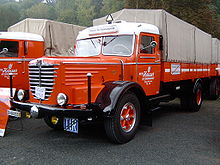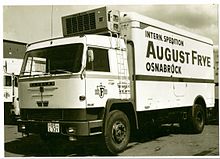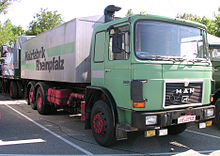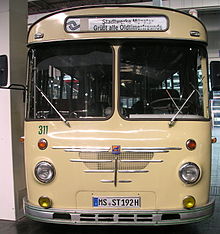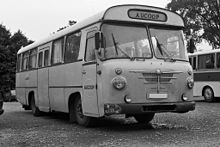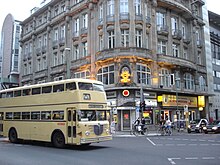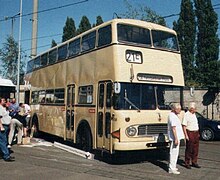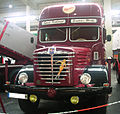Büssing AG

The Büssing was from Heinrich Büssing in 1903 as Heinrich Büssing, Special factory for motor trucks, motor buses and engines, Braunschweig , Elmstraße founded and developed into one of the largest suppliers of buses and lorries in Central Europe with significant exports and overseas. Since the 1930s in particular, the omnibuses with the lion emblem have shaped the image of urban traffic. Büssing's specialty were vehicles with underfloor engines . In 1971 the company was taken over by MAN .
Company history
1903–1920: Heinrich Büssing, special factory for motor trucks, motor buses and engines
Together with his two sons, the mechanical engineer Heinrich Büssing founded the Büssing factory for the production of commercial vehicles in a disused laundry in Braunschweig's Elmstraße, after he had already designed a bus for ten people around 1900.
The first omnibus for twelve people, presented in 1904, ran regularly from June 5, 1904 at a maximum speed of 30 km / h on the Wendeburg - Braunschweig route of Büssing's own Automobil-Omnibus-Betriebs-Gesellschaft Braunschweig . This model, from now on in series production, was exported to London as a deck seat bus in the same year.
The largest bus model at that time was a 38-seat deck- seat bus as a forward control (the driver's seat was above the engine) for the Allgemeine Berliner Omnibus-Actien-Gesellschaft (ABOAG).
During the First World War , bus production was suspended, and operations were at full capacity due to the production of the standard 3-tonne truck, which was standardized for use in the war .
Fross-Büssing
In 1908 Büssing's daughter Hedwig (called Hete) married the Viennese mechanical engineer Anton Fross . In 1909 he founded a machine factory in Vienna- Brigittenau , which from 1915 produced trucks under the license of his father-in-law under the name Fross-Büssing . After the collapse of the Habsburg monarchy, the license acquired for Austria-Hungary allowed the establishment of another Fross-Büssing plant in Prague , which existed as Tavarna na stroje Anton Fross-Büssinga Liberta from 1920 to 1931.
From 1928 the Vienna plant supplied the majority of buses for public transport in Vienna before 1945 (more than 100 of a total of around 130 units), but was shut down after the end of the Second World War.
1920–1922: Heinrich Büssing Automobilwerke KG
Due to the changed economic situation after the war, the company had to convert into a limited partnership in 1920 .
In the early 1920s, the graphic artist and later well-known animal photographer Hermann Fischer designed a new logo as a brand for the automobile company - a stylized Braunschweig lion in the colors of the old Duchy of Braunschweig , blue and yellow. On June 10, 1923 Automobilwerke H. Büssing AG had Fischer's version protected under trademark law.
1922–1931: Heinrich Büssing Automobilwerke AG
The company headquarters was now in Braunschweig on Salzdahlumer Straße.
After a renewed transformation into a family stock company , the number of model variants was drastically reduced in order to start assembly line production based on the American model from 1926. As a result, production increased to 250 chassis for buses and trucks per month.
Annual output was noticeably reduced during the global economic crisis .
In 1929 a three-axle forward control bus was presented under the name Trambus , the engine of which was installed between the front and rear axles along the direction of travel. This design was developed by Büssing and remained a trademark for many of the company's vehicles until 1971.
1931–1943: Büssing-NAG, Vereinigte Nutzkraftwagen AG
Büssing took over the financially troubled NAG , a subsidiary of AEG , and was thus able to offer a larger product range of commercial vehicles and become the industry leader. After the acquisition of the Franz Komnick und Söhne AG automobile factory , its production facilities in Elbing ( East Prussia ) were run under the name Büssing-NAG Werk Ost .
The company itself moved its headquarters to the current Heinrich-Büssing-Ring 40 in Braunschweig. In addition to the Braunschweig lion, a specific chrome-plated radiator face was introduced as a further identification feature in 1933, consisting of a longitudinal strut and a number of transverse struts that varied over time; this lasted, in the end only in the form of small wings next to the Büssing lion, until the end of independent production. As early as 1938, the first attempts were made with a truck with an underfloor engine .
1943–1950: Büssing-NAG Nutzkraftwagen GmbH
The family AG was dissolved in 1943 and transformed into a GmbH .
The production facilities in Braunschweig were badly damaged after air raids in the Second World War , and the undamaged factory in Elbing was no longer available. With the elimination of the bodies previously manufactured in Elbing, bodies from other companies such as Ludewig , Danz or Kässbohrer , later also FAKA , were increasingly manufactured on Büssing chassis. In sub-camp Schillstraße forced laborers were interned for the war production of bussing.
1950–1960: Büssing Nutzkraftwagen GmbH
The Büssing family took over the last shares in the AEG and converted the Büssing company back into a purely family company. The plant in Braunschweig was expanded and in 1954 received a modern staff and social building with a canteen, in which, for example, a warm lunch was given to employees for 0.50 DM .
1960–1971: Büssing-Automobil-Werke AG
After a reorganization of the company structure, Büssing became a stock corporation and, from 1965, relocated the production site to Salzgitter-Watenstedt in Industriestrasse in the middle of 159–179. Since Büssing offered classic long-hooded and forward control vehicles in parallel with the forward control models with underfloor motors, there was considerable additional effort in design and manufacture.
Büssing made a profit for the last time in 1960. In 1962, Salzgitter AG joined the company and took it over completely by 1968. At Büssing, however, the construction of the underfloor motor was still fully convinced and subsequently developed further models with this drive concept. Examples include the Büssing Commodore type 16-210, in which the underfloor principle was also to be applied to the semi- trailer, but of which only a few were built, as well as the Supercargo deck truck (both around 1965), whose entire base area covered The driver's cab attached under the loading area was available for standardized transport containers. These technically sophisticated constructions resulted in high development costs for the company, which ultimately turned out to be bad investments. Büssing came too early with its pioneering design (standardized ISO containers only became established for road transport in the 1970s), so that the model could not be sold. After the enormous costs that Büssing devoured themselves began to endanger the parent company, the latter gradually sold its daughter between 1968 and 1972 to its competitor MAN .
1971: Takeover by MAN (MAN-Büssing)
In 1971 MAN took over management at Büssing. Until the end of the year, the previous name Büssing was continued independently, from January 1, 1972, Büssing AG only produced for MAN. From this point on, the vehicles bore the MAN-Büssing logo , but were registered with the Federal Motor Transport Authority as MAN production. With the company lease agreement between Büssing and MAN dated May 30, 1972, Büssing leased the plants in Braunschweig and Salzgitter- Watenstedt to MAN. With this, the Heinrich Büssing Commercial Vehicles company ceased to exist.
Büssing omnibuses and trucks with underfloor engines remained almost unchanged in production under the double name MAN-Büssing until 1973, while forward control trucks with a vertically installed engine and hooded trucks had not been produced since 1972. The widespread VÖV standard line buses were also expanded , from 1972 as MAN-Büssing and later as MAN buses at the Salzgitter-Watenstedt plant. After that, the Büssing driver's cab on the trucks was initially replaced by that of the comparable MAN-owned model, while the technical underfloor construction from Büssing initially remained in the program and was continued by MAN under its own management for several years.
After a transition phase, the name Büssing also disappeared from trucks and buses, where instead of the double name MAN-Büssing only the name MAN was used: MAN manufactured buses and trucks under the name MAN-Büssing until 1979. However, the Büssing company logo, the Braunschweig lion , has survived : it can still be found - albeit in a modernized form - on the radiator grille and steering wheel of MAN commercial vehicles .
vehicles
Omnibuses
Büssing motor bus
In 1904 the prototype of a 20 hp motor bus with chain drive and a top speed of 30 km / h was created, which went into series production in various forms, for example as a deck seat bus. The frame consisted of U-beams (from the railway construction), the wheels had hard rubber tires. The vehicle had a patented rear axle suspension and a differential lock.
Motor bus type IV
The cab-over type IV was in 1906, among others, for the ABOAG built.
Motor bus type II, III
In 1909 the cardan drive was used.
Motor bus type VI
From 1923 onwards, Büssing manufactured buses with three axles, from which the two rear axles were driven. These buses were also fitted with double-decker bodies by body builders .
Mid-engine bus type VI GR
The first bus with an underfloor engine appeared in 1929 as a three-axle forward control under the type designation HAWA - Trambus . The engine was mounted between the front and rear axles and could be swiveled out to the side.
O-bus type CuU 33F
In 1933 a prototype of this trolleybus was delivered to the Berliner Verkehrsgesellschaft .
Trambus 285 T to 650 T, 900 T
After Büssing constructed a trambus exclusively for its own purposes in 1932, which could not be seen at exhibitions or in regular service, they presented the first series models of the trambus in front control at the automobile exhibition in 1935. The diesel engines exclusively used in these models were arranged in a standing position next to the driver. Some of the superstructures had clear streamlines. It was not until 1938 that the three-axle model 900 T followed, but larger numbers of which were only delivered to Berlin for single-deck superstructures.
Trambus 650 TU and 900 TU
In 1936, Büssing presented the first series-produced trambuses with the types 650 TU (two-axle) and 900 TU (three-axle), the drives of which were now installed below the driver. For this purpose, the in-line six-cylinder UD 6 with 145 hp was developed from the standing GD-6 engine. In addition to the Elbingen plant , the superstructures for this were supplied by various bodywork companies.
From the beginning of the war , the models were no longer included in the program, but the U-Bus prototype followed in 1941 , in which the motor was installed in the cranked frame in the middle between the axles. If the presentation was followed by a smaller series 650 TU with a Kässbohrer body for Warsaw, it remained (according to the current status) with the three-axle prototype built by Elbing with a short wheelbase that was in use in Hanover.
Type SS and type DS articulated buses
From 1932 omnibus trailers were built in the form of semi -trailers .
War omnibus 4500 T
In 1942 the trambus type 500 T (introduced in 1938) was changed to 4500 T due to the type restriction in the National Socialist Schell Plan . The technical specifications and frame dimensions of the model hardly changed. The six-cylinder unit diesel engine with the designation LD, which could produce 107 hp, was used. In addition to the company's own plant in Elbing, various bodywork companies were responsible for building the model. Due to the material used, the structures were simplified more and more as the Second World War progressed. At the end of the war, the framework was only filled in with pressed cardboard and simple window glass.
Half-track vehicles 1934–1944
BN l4, BN l5, BN l7, BN l8, BN 9 and BN 9b
Bus type 5000 T, 5000 TU
When Büssing again received a production permit from the British control authorities in May 1945, immediately after the Second World War, production of the 4500 T was resumed. In the course of the year it was given its actual designation 5000 T (105 Büssing with 105 hp), which is based on the utility class. At first it was delivered exclusively to the allied control authority; It was not until mid-1947 that civilian operations could also receive vehicles on a purchase order, provided they could prove an urgent need. The first bodies were initially produced by the Ludewig brothers in Essen, and then by the Recklinghausen vehicle factory from autumn 1947. The chassis , which Büssing was unable to body itself due to the loss of the Elbingen plant, was manufactured until autumn 1949, but some of the last superstructures from body shops were not delivered until 1952.
In May 1949, the successor model 5000 TU with an underfloor motor between the axles was presented at the Hanover Export Fair , which was based on the prototype of the U-bus manufactured during the war, but was further developed in terms of technology and structure. The newly developed six-cylinder underfloor diesel engine of the U9 type with an output of 135 hp was arranged below the top edge of the frame between the front and rear axles. The construction of the only prototype came from the vehicle factory Kannenberg (FAKA) in Salzgitter . In contrast to the later series versions of various body manufacturers, the prototype had two wide, all-round decorative strips that were interrupted at the front, two bumper corners instead of a continuous front bumper and a truck hood side panel attached to the right-hand side of the vehicle with the slot arrangement typical of Büssing at the time in wing shape for ventilation of the right side of the engine. These details adorned numerous advertising printed matter from the Büssing company, as well as a 1:90 scale vehicle model ( nominal size H0 ) commissioned from Wiking Modellbau .
Chassis production began in autumn 1949, but was initially only available with external bodies. Compared to the prototype, the 5000 TU manufactured in 1950 with a factory structure in the Querumer Büssing factory only had the upper, wide, circumferential decorative strip, which was interrupted at the front. Outwardly striking were the twin headlights arranged one below the other.
In 1951 the numbers were omitted from the type designation, the gross vehicle weight was increased from 13 to 13.6 t and the model was visually revised. The upper decorative strip already ended in front of the front, the fog lights were no longer placed under the main headlights, but below them and inwards, the Büssing spider was wider. In 1952 the two thousandth trambus rolled off the assembly line.
Omnibus 6000 T, 6500 T, 4000 T
At the end of 1952, the TU was replaced by the 6000 T with a new six-cylinder underfloor diesel engine of the type U10 with 150 hp. The 6500 T followed in 1954 and was manufactured until 1957.
In 1955, Büssing and the coachbuilder Ludewig launched the 6500 T Aero one and a half-decker .
The small Omnibus 4000 T appeared in 1954 with a new type of composite construction, whereby the chassis only received its full strength together with the body.
Omnibus TU 5, TU 7, TU 11, TU 10
The new series were given a type designation based on the cubic capacity of the diesel engine. In addition to Auwärter Neoplan , Büssing delivered the first air-sprung buses with these vehicles . As the last model, the TU 10 was also available in a frame construction.
Articulated trains from Emmelmann , Gaubschat , Kässbohrer and Vetter were added to the program because new bus trailers were no longer permitted from 1960 and general operation with people in trailers was no longer permitted in the Federal Republic of Germany from 1963 .
Omnibuses in tubular design
A new generation of buses came on the market in 1959. The self-supporting tubular design resulted in more fluid body shapes. The initial type designations with RU were replaced from 1961 by the sales designations Konsul , President and Senator (later Prefect ). The numbers in the type designations denoted the maximum possible number of rows of seats, thus providing indirect information about the vehicle length. In the 1960s, Büssing achieved a considerable market share in the Federal Republic of Germany with these models:
- 50% of the single-deck buses
- 44% of articulated buses
- 82.5% of the one-and-a-half-decker buses manufactured by the Ludewig Brothers body factory in Essen-Altenessen
The construction company Emmelmann in Hanover was involved in coaches (among others) - sales logo Büssing-Emmelmann .
consul
The former 8RU5 coach was also purchased in large numbers by the German Federal Armed Forces to transport troops. This version had double folding doors in the middle and a hinged door at the front.
president
The progressive President series (formerly type 14RU10) with a horizontal U7 6-cylinder underfloor in-line engine behind the front axle with a floor height of 920 mm was already equipped with air suspension . In the stern, a wide entrance with a large, lower platform could also be provided for conductors. The chassis was also suitable as a towing vehicle for articulated buses or as a one-and-a-half-decker, which were built by Emmelmann and Ludewig. At the end of the 1960s, the President 14 (11,850 mm length) became the intercity bus BS 120 N (5,850 mm axle base, 11,710 mm length) and the suburban bus BS 120 V (5,400 mm axle base, 11,700 mm length) with a new angular body (high side windows, flat roof), which anticipated some design elements of the standard intercity bus planned at the time and were delivered in large numbers to the Deutsche Bundespost and Deutsche Bundesbahn .
Senator / Prefect
The sales name Büssing Senator included the former regular service buses 11 RU to 15 RU 7H with U7 underfloor motor lying lengthways in the rear. It had the same front as the President, but the side window struts ran at an angle, in keeping with contemporary tastes. In 1965 this series got a new type of axle guide with a wider track at the front and was then called Büssing Prefect . From 1966 it was also available with a more angular front. From 1963 to 1970, this type was also supplied as a self-body double-decker bus with 94 seats (Senator or Prefect 25 or 26) to various companies in Germany and abroad in various lengths. There were also double-deckers for Stockholm, which were low-floor and pedestal from the front to the center door and each had a staircase to the upper deck above the wheel arches on the left side of the car.
VÖV standard line buses
From 1968 the Prefect was available with the new angular structure according to the specifications of the VÖV standard bus in three different lengths: Prefect 11 Standard (9.57 m), Prefect 13 Standard (11 m) and Prefect 14 Standard (11.3 m). From 1970 the type designations changed to BS 100 V, 110 V and 113 N. When it was taken over by MAN AG , the 11 m type, which was still being produced in Salzgitter-Watenstedt , changed to the local range and was known as MAN for a while -Büssing SL 195 sold.
Omnibuses for regular services in the city of Berlin
Shortly after the founding of the Büssing company, ABOAG bought its first buses for regular urban transport. They stayed true to this brand until the end. Büssing omnibuses thus became part of the cityscape.
As a rule, the bodies were not created by Büssing, but by body manufacturers, mostly in Berlin . The type designations were determined by the Berlin transport company .
Double-decker bus type D 38
From 1938 to 1946, the Berliner Verkehrsbetriebe received three-axle double-decker buses of this type with a hood engine, which had chassis from both Daimler-Benz and Büssing.
D2U double-decker bus
This two-axle double-decker bus with an underfloor engine on the right-hand side behind the front axle was delivered from 1951 to 1964 and is therefore the typical double-decker bus in West Berlin in the post-war period. Because of the height restrictions in Germany, these cars had a lower-lying side aisle on the left side and four-seat benches on the upper deck. The rear platform, which was initially open and on which the stairs to the upper deck were located, was closed with a four-part folding door from 1963 onwards by order of the supervisory authority, without an accumulation of accidents beforehand. The younger series have been upgraded with this. In the colloquial language of the BVG staff, these buses were called trampling cars , as the conductors had to go through the car to the passengers due to the lack of a permanent conductor's seat (shuttle conductors ). In 1978 the last D2U was taken out of service. On special occasions, the preserved car 1629 will continue to be used by AG Traditionsbus in Berlin to transport passengers on special trips.
Double-decker bus D3U
This is the three-axle version of the D2U that was delivered in 39 units in 1952. In contrast to the self-supporting structure of the D2U, a strong and heavy chassis frame was necessary here. This explains the third axle, because at 11.1 meters the car was only 70 centimeters longer than the D2U. One copy has been preserved in the Municipal Transport Collection Monument Hall of the German Museum of Technology in Berlin.
DF double-decker bus
In 1964/65, 29 double-decker buses with a permanent conductor's seat to the right of the rear entrance were manufactured for the BVG . In addition to the usual underfloor motor between the axles, they had air suspension and a lowered central aisle in the lower deck, so that the floor in the upper deck could be made flat and the benches could also be placed here on both sides. Because of the flow of passengers from the back to the front, this series was given a staircase at the back (ascent) and at the front (exit) and a door in front of and behind the front axle for passengers to exit from the upper deck and lower deck. Since the BVG decided to introduce the (conductorless) one-man operation also in the double-decker area, this series was no longer procured.
Double-decker bus DE / DES
From 1965 to 1974, the body Company Gaubschat, built Orenstein & Koppel and DWM with Bussing suspension components double-decker buses with a front and a middle automatic double-folding type DE ( D oppeldeck- E Inmann-cart) for the BVG. The Lübeck-Travemünder Verkehrsgesellschaft (LVG) also bought some cars . These buses were designed for one-man operation without a conductor. Part of the DE series in Berlin was temporarily converted in the late 1970s for the Schaffner operation and had been referred to as Type DES (DE-bus with S chaffner). What was striking about this bus (like the last D2U buses) was the howling two-stage Voith -Diwabus automatic transmission that sounded like a turbine. The DE cars shaped the streets of West Berlin in the 1970s and early 1980s. Pictures of the Büssing DE at Wikimedia Commons .
Trucks
The trucks of the Büssing brand were also known beyond the borders of Germany . The old Büssing logo - the Braunschweig lion - is still emblazoned today on all MAN trucks in which the Büssing company was absorbed.
Büssing truck before 1945
- 1903: 2 tonne motor truck
- 1904–1907: 3 ton motor truck
- 1907–1916: Type II 2–2.5 t
- 1907–1911: Type IV 4.5–5.36 t subsidy truck
- 1907/1908: Type VB 25 5 t
- 1908–1913: Type III 3–3.5 t
- 1909–1912: Type V 4.5–5 t subsidy truck
- 1909–1914: Type VI 5.13–6.69 t
- 1911–1913: Type IV B forward control 4 t
- 1912: F13 fire brigade
- 1913/1914: Type V 4.7 t subsidy truck
- 1915–1923: Type V subsidy truck
- 1916/1917: KZW 1800
- 1919–1924: Type II 2.5 t
- 1919–1924: Type III 3.6 t
- 1919–1924: Type III GL 3.5–4 t pneumatic tires
- 1919-1924: Type IV 3.5-4 t
- 1924–1928: Type III GE 3–3.5 t
- 1924–1931: Type III GL 3–3.5 t
- 1924–1930: Type IV G 4–5 t
- 1924–1930: Type VG 5–6 t
- 1924–1930: Type VI GL 6 t
- 1927–1930: Type III GL B 3–3.5 t
- 1931–1936: Type 15 1.5 t
- 1931–1936: Type 20 2 t
- 1931–1936: Type 25 2.5 t
- 1931–1936: Type 30 / 30L 3–3.6 t
- 1931/1932: Type 40 (N) 4 t
- 1931/1932: Type 80 (N) 9.35-11.5 t
- 1932–1936: Type 275 2.75 t
- 1933–1937: Type 350 3.5 t
- 1933–1936: Type 400/401 4 t
- 1933–1935: Type 801/802 8.2–8.5 t
- 1935–1937: Type 260 2.6 t
- 1935–1937: Type 305 3–3.5 t
- 1935–1937: Type 375 3.5–4 t
- 1935–1937: Type 502 5.5 / 6.5 t
- 1935–1941: Type 504 VA (4 × 4) 6–6.25 t
- 1935–1937: Type 550 5–5.5 t
- 1935–1939: Type 650 5.5 / 6.5 t
- 1936–1938: Type 1.5 (15 castle lions)
- 1936–1938: Type 2 (20 castle lions)
- 1936–1938: Type 2.5 / 25 Burglöwe
- 1936–1939: Type 30/300 Burglöwe
- 1936–1942: Type 654 (4 × 4) 5.75–6.25 t
- 1936/1937: Type 900 (N) 8.35–11.5 t
- 1938/1939: Type 500 G
- 1940/1941: Type 500 S 4.6-5.25 t
- 1942-1945: 4500 S-1 4.6 t
Büssing truck after 1945

Types with diesel engines: S = standing, U = lying / underfloor
- 1945–1950: 5000 S 5.35 t
- 1948–1950: 7000 S 7 t
- 1950-1952: 5500 (S) 5.6-5.7 t
- 1950-1956: 8000 (S) 8-8.2 t
- 1951–1956: 12000 U 12 t
- 1952: 6000 / S
- 1952: 8000 U
- 1952–1958: 8000 S 13 - 180 hp, 1600 rpm, 13,539 cm³ displacement - the large long-distance truck.
- 1953/1954: 4000 4.5 t
- 1953-1956: 6000 S (6500) 6.3 t
- 1953/1954: 8000 (U) 7.8 t
- 1954-1956: 7500 S 7.65-7.75 t
- 1954-1956: 7500 U 7.65-7.75 t
- 1955/1956: 4500 U 4.5 t
- 1957–1960: LS 11 8.15–8.25 t
- 1957–1960: LS 11 F 7.5–8.4 t
- 1957/1958: LS 5 5-6 t
- 1957-1960: LS 7 6.15-6.45 t
- 1957-1960: LS 7 F 6.1 t
- 1957-1960: LU 11 7.5-8.4 t
- 1957–1959: LU 7 6.6 t
- 1959/1960: LS 55 Burglöwe 4.6-5.2 t
- 1959/1960: LS 711 F / 3 12-13 t
- 1959/1960: LS 75 7.45-7.6 t
- 1959/1960: LS 77 7–7.2 t
- 1959/1960: LS 77 F
- 1959/1960: LU 55 Burglöwe 4.7–6.3 t
- 1959/1960: LU 75 7.55-7.7 t
- 1959/1960: LU 77 7-7.2 t
- 1961–1963: Burglöwe LS 5/10 6.1 t
- 1961–1963: Burglöwe LU 5/10 6.1 t
- 1961–1963: Commodore LS 11/16 7.7 t
- 1961–1963: Commodore LS 11 / 16F 8.5 t
- 1961–1963: Supercargo LS 7/14 8.2 t
- 1961–1963: Supercargo LU 7/14 8.2 t
- 1963–1967: Burglöwe SAK 5.95 t
- 1963–1966: Burglöwe Universal (4 × 4) 5.5 t
- 1963-1965: Commodore F3 (6 × 4) 19.3 t
- 1963–1966: Commodore FS 8.9 t
- 1963–1966: Commodore SK 8.6 t
- 1963–1965: Commodore U 8.9 t - 192 hp
- 1963–1965: Supercargo SK 8 t
- 1963–1966: Supercargo U 8.55–8.65 t
- 1964–1967: Burglöwe 65 6.2–6.35 t
- 1965-1967: BS 09-110 4.5-4.85 t
- 1965–1967: Commodore 16–210 9.8 t
- 1965–1965: Commodore 22–210 AK 11 t short-nosed truck
- 1965–1965: Commodore 22–210 AS 15 t short-nosed truck
- 1965–1966: Supercargo 14–185 8 t
- 1963–1967: Supercargo 22–150 14.7 t deck truck
- 1965–1967: Commodore U 11 D - 210 HP, 2100 rpm, 11,580 cm³ displacement (last series wooden frame cab)
Borgward Type B 2000 A / B
Bj. 1955–1961
Bj. 1962 - Büssing
- 1966–1969: BS 14 AK 7.9 t
- 1966-1969: BS 14 L 7.9-8.1 t
- 1967-1971: BS 11 L 5.7-6.3 t
- 1967-1971: BS 11 LT 5.7-6.3 t
- 1967-1971: BS 16 L 8.6-8.8 t
- 1967–1971: BS 16 S 9.5 t
- 1967-1971: BS 22 L 12.9 / 13.4 t
- 1968–1971: BS 12 L 6.5 / 7 t
- 1968-1971: BS 13 L 7.2 / 7.7 t
- 1968: BS 15 AK 8.2 t
- 1968–1971: BS 15 L 8.9 / 9.4 t
- 1969–1974: BS 16 SK 8.1 t
- 1969–1971: BS 22 K 13.4 t
- 1969–1971: BS 22 L 22 t
- 1969–1971: BS 22 S 13.5 t fifth wheel load
- 1969–1971: BS 26 K 17.4 t
- 1969–1971: BS 32 K 23.4 t
Büssing BS 16 underfloor - (with Louis-Lucien-Lepoix -Design)
See also
literature
- Wolfgang H. Gebhardt: Büssing Omnibusse 1904–1971 (= Schrader Motor-Chronik, Vol. 81). Motorbuch-Verlag, Stuttgart 1998, ISBN 3-613-87171-8 .
- Wolfgang H. Gebhardt: Büssing trucks and tractors 1903–1971. A documentation (= Schrader Motor Chronik, Vol. 88). Motorbuch-Verlag, Stuttgart 1999, ISBN 3-613-87183-1 .
- Wolfgang H. Gebhardt: Type compass: Büssing trucks 1903–1971 . Motorbuch-Verlag, Stuttgart 2001, ISBN 3-613-02154-4 .
- Wolfgang H. Gebhardt: German omnibuses since 1895 . Motorbuch-Verlag, Stuttgart 2002, ISBN 3-613-02140-4 .
- Commercial vehicles from Braunschweig . Edition Diesel Queen, Berlin 1993, ISBN 3-926574-02-X .
- Bernd Regenberg: The German trucks of the sixties - Volume 1: Büssing-Faun-Hanomag-Henschel . Podszun engine books , 1991, ISBN 3-923448-68-6 .
- Eckhard Fischer: The Büssing company (= contributions to the history of the town, published by the archive of the town of Salzgitter, No. 24). City of Salzgitter, 2010. Size 224 pp.
- Eckhard Fischer: The bus construction of the Büssing company in Braunschweig. In: Braunschweigische Heimat , Braunschweigischer Landesverein Geschichte-Heimat-Natur eV , Braunschweig 2011. Volume 97, No. 1, pp. 10-12 and No. 2, pp. 14-16, ISSN 2198-0225 .
- Eckhard Fischer: Dr.-Ing. E. h. Willy Staniewicz . A life for technology at Büssing. (= Contributions to the history of the town, published by the archive of the town of Salzgitter, No. 27). City of Salzgitter, 2013. Extent of 168 p.
- Peter F. Linhart: Büssing all along the line. EK-Verlag, Freiburg 2013
Web links
Individual evidence
- ↑ Barbara Klössel-Luckhardt: Industrial trademarks in the Braunschweig region. P. 803.
- ↑ Heinz Eichhorn: Hermann Fischer, the old master of animal photography on his 90th birthday. P. 25.
- ↑ Barbara Klössel-Luckhardt: Industrial trademarks in the Braunschweig region. P. 805.
- ↑ Information on the restoration of the bus ( Memento from February 15, 2013 in the Internet Archive )
- ↑ Information about the bus with lots of old photos
- ↑ Air-sprung trambus . In: Motor vehicle technology 11/1961, pp. 471/472
- ↑ New Büssing intercity bus . In: Der Stadtverkehr , issue 9/1969, p. 259, Verlag Werner Stock, Brackwede 1969
- ↑ Peter F. Linhart: Büssing all along the line. The Senator, Prefect and President buses . EK-Verlag, Freiburg 2013, ISBN 978-3-8446-6750-9 , p. 10, 48
- ↑ Werner Stock: The sheepnel-free double-deck bus as a seat vehicle . In: Der Stadtverkehr , Issue 8/1964, pp. 223–228, Verlag Werner Stock, Brackwede 1964
- ↑ Dieter Hanke: Ahead of his time • Büssing double-decker Senator 25 - BS 110 DD . In: Omnibusspiegel , Issue 10–9, pp. 21–33, Verlag Dieter Hanke, Bonn 2011
- ^ Werner Stock: More Büssing double-deckers for Stockholm . In: Der Stadtverkehr , issue 2/1967, p. 40/41, Verlag Werner Stock, Brackwede 1967
Coordinates: 52 ° 8 ′ 31.2 " N , 10 ° 25 ′ 7.6" E


